22 Cold Email Statistics You Need to Know

Everyone has their own ideas on the best way to do cold outreach. At Hunter, we take a data-driven approach to everything we do. That’s why we set out to find the top studies on cold outreach and uncover insights you can use to get more replies from your leads.
In this post, we’ll go over the most interesting cold email statistics, discuss what they mean, and explain how you can use them to your advantage.
General cold email statistics
We’ll start by looking at some general cold emailing statistics before going more in-depth on subject lines, follow-ups, open and reply rates, and more.
1. Email is almost 40 times more effective at securing customers compared to social media
It’s been proven time and again that email is the most effective channel for generating new customers. According to a McKinsey study, it’s almost 40 times more effective than social media.
If you’ve been on the fence about whether to try out cold email outreach, we’re here to tell you that it definitely works.
Here are just a few examples of people and companies that have seen success with cold email:
- Jake Jorgovan landed Fortune 500 clients using cold email
- Alex Berman closed $400,000 worth of deals in 30 days with cold email
- Belkins landed a six-figure client thanks to cold email
- Laura Lopuch grew her freelance business by 1400% using cold email
2. 80% of people prefer sales reps to contact them via email
People are busy. Most don’t have the time to spend 30 minutes on the phone with a sales rep, listening about a solution they’ve never heard of and might not need.
It’s not surprising that 80% of people prefer sales reps to contact them via email. If you think about it, it makes a lot of sense. A phone call can interrupt your day, and a social media DM is too personal for a sales pitch. This makes email the perfect medium for reaching out to prospects.
By using email to contact prospects, you give them time to think about your offer and allow them to get back to you when it’s most convenient for them.
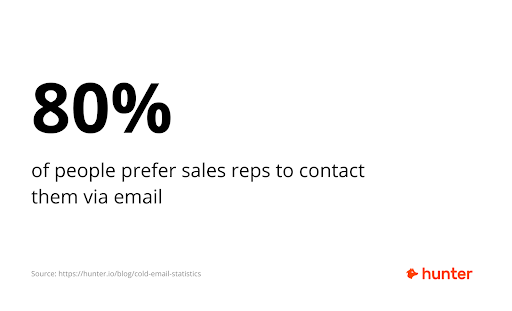
3. Sales reps spend 21% of their workday on writing emails
Given how effective emails are at engaging prospects and generating meetings, it’s no wonder the average sales rep spends a fifth of their day writing emails.
This includes writing and sending cold emails, replying to prospects, and setting up meetings.
The rest of their time is spent on sales meetings, data entry, prospecting, internal meetings, scheduling, and training.
4. C-level executives are 23% more likely to answer cold B2B emails than employees outside the C-suite
It's no secret that proper targeting is the key to a successful cold email campaign. And in most scenarios, proper targeting means reaching out to people who have the power to act on your offer.
According to a study by Belkins, C-level executives are 23% more likely to reply to cold emails than their subordinates.
So before sending your next campaign, make sure your prospects have the internal leverage needed to say "yes."
Cold email subject line statistics
The subject line has a significant impact on the effectiveness of your cold email. Let’s look at some important cold email subject line statistics.
5. 33% of people open emails based on the subject line alone
The subject line is the first thing a prospect will notice about your cold email. In fact, it’s the main thing that a prospect will look at when deciding whether to open your email or not.
According to a SuperOffice study, 33% of email recipients decide whether to open an email based on the subject line alone.
This makes it clear that you need to spend the time to craft an effective subject line if you want to maximize the chances of your cold email getting opened.
As you’ll see from the following statistics, the best-performing subject lines are personalized and spark curiosity. Additionally, they often include numbers or a question.
6. Emails with personalized subject lines get 50% higher open rates
Anyone who’s done more than a couple of cold email campaigns knows that personalization can impact open rates significantly.
A study published by Yes Lifecycle Marketing confirms this and reveals that emails with personalized subject lines get 50% higher open rates.
According to the same study, however, only 2% of emails use personalization.
Consider using these personalized subject lines if you’d like to improve the open rate for your cold emails:
- Hey {{first_name}}
- Idea for {{company}}
- Nice to meet you at {{event}}
- A better way to solve {{pain point}}
For more personalized subject line ideas, check out this post.
7. Adding the prospect’s company name in the subject line can increase open rates by 22%
A popular way to personalize a cold email subject line is to include the name of the prospect’s company. This type of personalization is popular for a good reason — it can increase your open rate by 22%.
The reason why this works is because it immediately lets the prospect know that the email is related to their job, which makes it more likely that they’ll open it.
Here are a few examples of cold email subject lines personalized with the prospect’s company name that you can use for your next email:
- [Your company] + {{company}} = ?
- Quick collaboration with {{company}}
- Resources that can help {{Company Name}} right now
8. Subject lines that include a question get 21% higher open rates
A good subject line arouses curiosity and makes the prospect eager to open the email. One way to accomplish this is to add a question to your subject line.
This can improve your open rate by up to 21%.
Here are some examples:
- Your thoughts?
- {{Name}}, can you keep a secret?
- {{first_name}}, can we connect?
- Ready to discuss {{problem}}?
- Are you happy with {{competitor}}?

9. Subject lines that include numbers get 113% higher open rates
Numbers can be very effective at getting people’s attention. That’s one of the reasons why the title of this blog post contains one. We managed to get your attention, didn’t we?
The same is true for email subject lines. In fact, emails with subject lines that include numbers get 113% higher open rates.
So, if you’re looking to boost the open rate for your next cold email, try including a number in the subject line. Here are a few ideas:
- X tips to help solve {{pain point}}
- X steps to reaching {{goal}}
- X options to get started
Cold email follow-up statistics
Whether you like it or not, following up with prospects is an essential part of cold outreach. Here are a few important cold email follow-up statistics.
10. Following up with a prospect multiple times can double your cold email response rate
You shouldn’t be discouraged if you don’t get a reply from a prospect after you send them an initial cold email.
Don’t immediately assume that they’re not interested — they could be busy or might have simply overlooked your email in their crowded inbox.
You should almost always follow up with a prospect if you don’t hear from them after your first email. According to a Backlinko study, sending multiple follow-ups can double your response rate.
While the exact boost you’ll get from sending multiple follow-ups depends on a lot of factors, it’s almost certain that you’ll improve your average response rate by sending follow-ups.
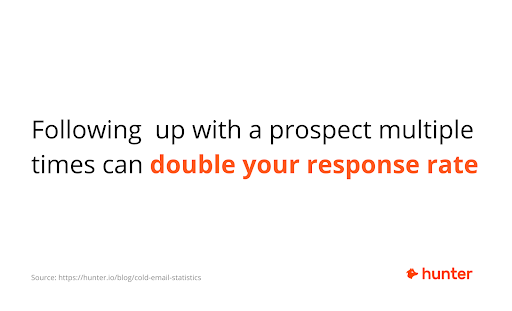
11. Cold email campaigns with 4 to 7 emails per sequence get three times as many responses compared to campaigns with less than 4 emails per sequence
If you’re not sure how many times to follow up with a prospect, data seems to show that it’s good to aim for between three to six follow-ups.
This can triple your reply rate. At Hunter, we’ve seen the best results when sending up to 3 follow-up emails.
12. 70% of cold emails don’t get followed up on
With how effective follow-ups are, it’s surprising to see that most people don’t follow up on their cold emails. In fact, 70% of cold emails don’t get followed up on.
Cold email open and reply rates statistics
Now we’re getting to the most interesting cold email statistics: those related to open and reply rates. So, what can you do to boost these two crucial metrics? Keep reading to find out.
13. Only 23.9% of all sales emails are opened
We already know that a lot of people decide whether to open an email based on the subject line. This means that a decent chunk of your prospects will delete your email without even opening it.
The data seems to confirm this, with a Gartner study showing that only 23.9% of sales emails get opened. Taking this into account, it’s obvious that you need to put extra effort into crafting your subject line if you want your emails to get opened. Here’s a guide that can help.
14. A mere 8.5% of cold emails receive a response
With very few cold emails getting opened, it’s expected that even fewer get a reply. A Backlinko study shows that only 8.5% of cold emails receive a response.
There’s a multitude of reasons why a prospect might not reply to your email, including:
- Being busy
- Overlooking your email in their inbox
- Your offer not being relevant or appealing to them
- Wrong timing
Again, whatever their reason for not replying might be, it’s crucial for you to follow up on your email at least once.
15. 24.45% of emails are opened on mobile
According to a GetResponse study, 24.45% of emails are opened on mobile devices.
While most email opens still happen on desktop devices, having one-quarter of your emails opened on mobile makes it crucial that you make sure your emails are optimized for mobile devices.
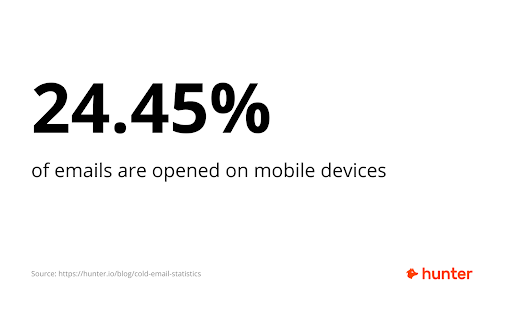
16. Adding multiple personalization fields can improve reply rates by 142%
We’ve already talked about how personalizing the subject line of your email can help increase open rates. But did you know that adding multiple personalization fields throughout your email can boost reply rates by up to 142%?
There are numerous ways you can personalize your email copy for each prospect, including mentioning their:
- Name
- Company name or industry
- Job role and associated duties
- Acquaintance or colleague
- City
- Favorite sports team
- Hobby
17. Emails that include 1-3 questions are 50% more likely to get a reply compared to those that don’t include a question
After introducing yourself and your offer to the prospect, you need to let them know what’s the next step in the process if they’d like to take you up on your offer. This is known as the call-to-action (CTA).
According to a study by Boomerang, it’s best to phrase your CTA as a question since emails that include between one to three questions get 50% higher reply rates.
Cold email timing statistics
When’s the best time to send a cold email? When’s the worst time to send it? Let’s find out.
18. 75% of sales emails are opened within the first hour
People check their email inbox multiple times a day, with some keeping it open in a browser tab at all times.
Keeping this in mind, the following statistic shouldn’t be shocking: 75% of sales emails get opened within the first hour of being received.
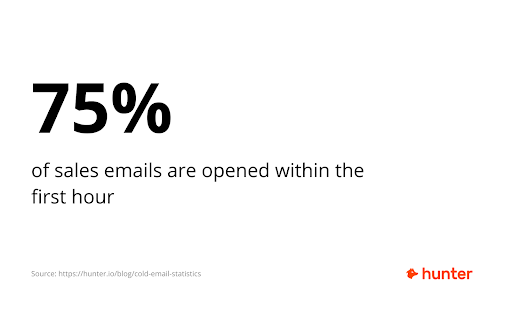
19. 42% of emails are replied to within the first hour
If you know that three out of four emails are opened within the first hour, you’d assume that a lot of those that get replied to receive a reply within the first hour as well. You’d be right — 42% of all emails are replied to within the first hour.
In other words, if you don’t get a reply to your email within a day or so, you’ll probably need to send a follow-up.
20. Emails sent on weekends get the lowest open rates
Most people try to avoid thinking about work on weekends and ignore business-related emails. That’s why emails sent on weekends get the lowest open rates.
For cold email campaigns, it’s usually best to avoid reaching out to prospects on Saturdays and Sundays.
21. Emails sent between 1 PM to 4 PM on workdays get the most replies
Campaign Monitor analyzed 100 billion emails to find out during which hours of the day emails get the best reply rates. They found out that emails sent between 1 PM to 4 PM on workdays get the most replies.
This makes sense because most people are at work during those hours and are likely checking their inbox often or keeping it open at all times.
You can learn more about the best time to send your cold emails here.
22. Emails sent on Fridays get the lowest reply rates
On Fridays, most people are finishing up their remaining tasks for the week and getting ready for the weekend. Expectedly, they are less likely to reply to your cold email during that time.
Use cold email statistics to create an effective outreach strategy
We’ve thrown a lot of statistics at you in this post. But, how do you make use of them to improve your next cold email campaign? Let’s recap:
- Spend the time to craft an effective subject line. The best ones are personalized, spark curiosity, and include a question.
- Don’t just personalize the subject line; add personalization to the body of your email, too. You can mention the prospect’s name, the name of their company, their industry, job role, favorite sports team, or hobby. This will make your message stand out from the average cold email and help boost your response rates.
- Avoid sending cold emails on weekends. If possible, do most of your cold outreach during the second part of the workday.
- You most likely won’t get a reply to the first email you send to a prospect. Be prepared to follow up multiple times if necessary.
That’s it. Now go out there and crush your cold outreach goals.



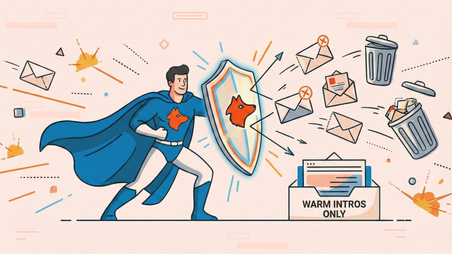
 Send cold emails with Hunter
Send cold emails with Hunter